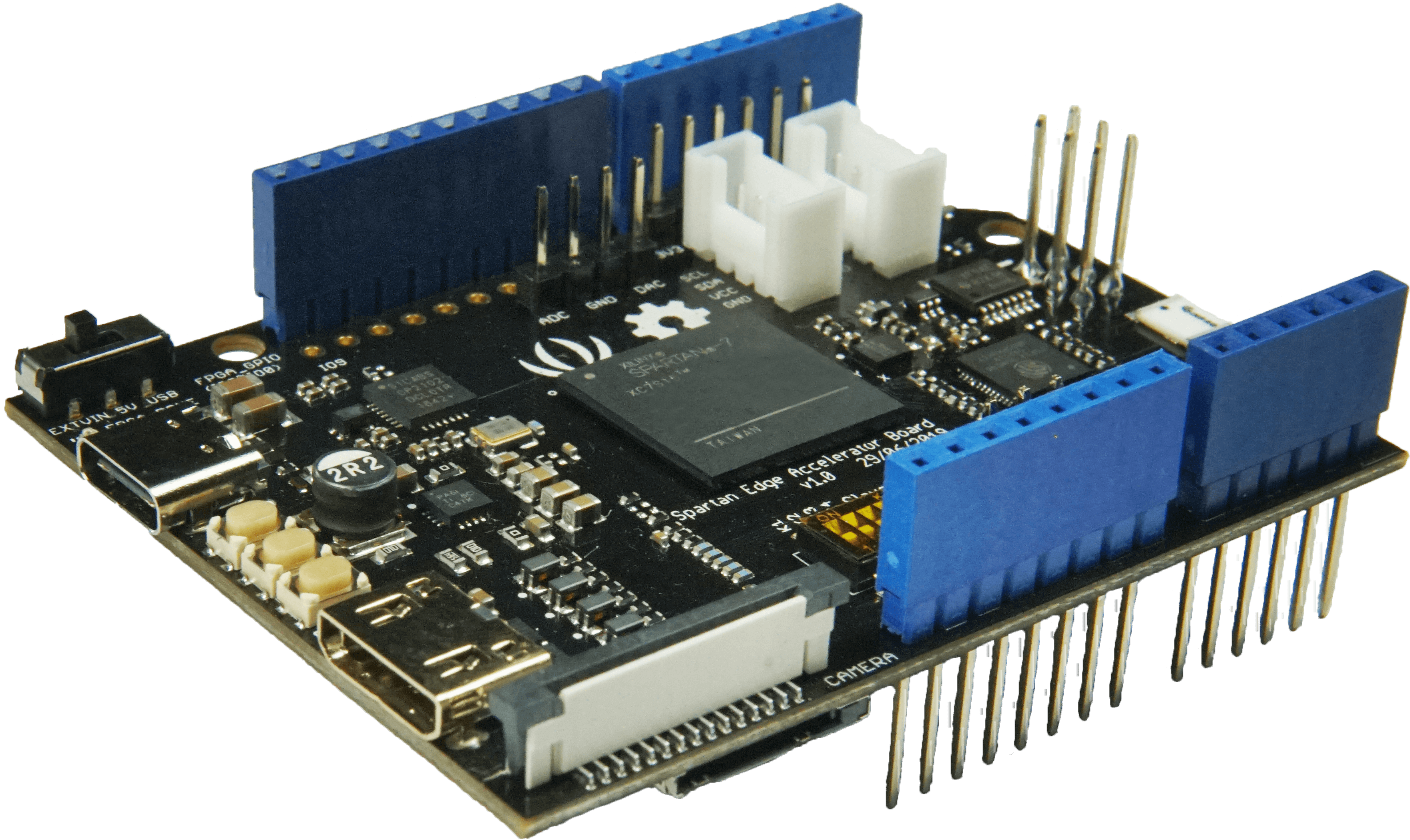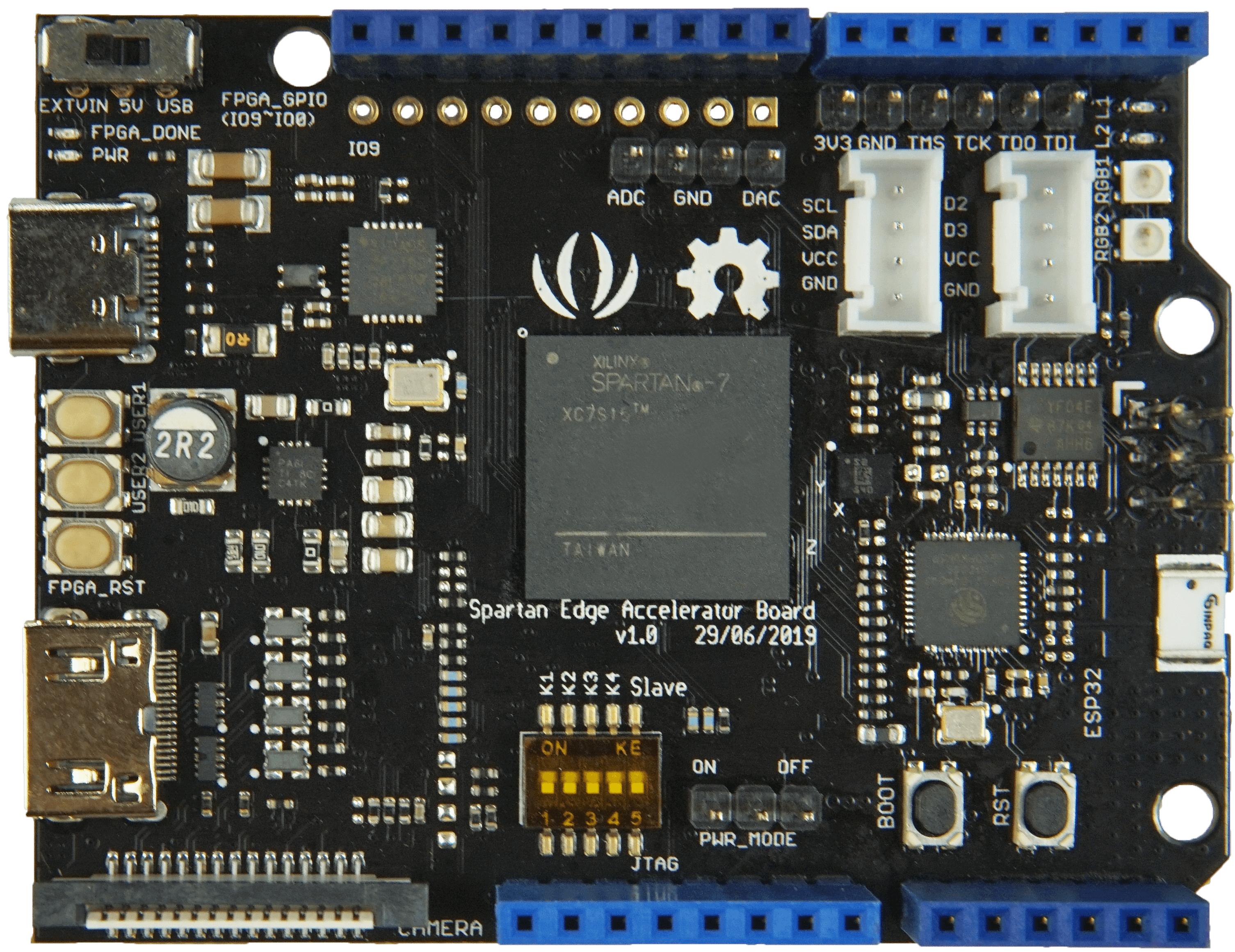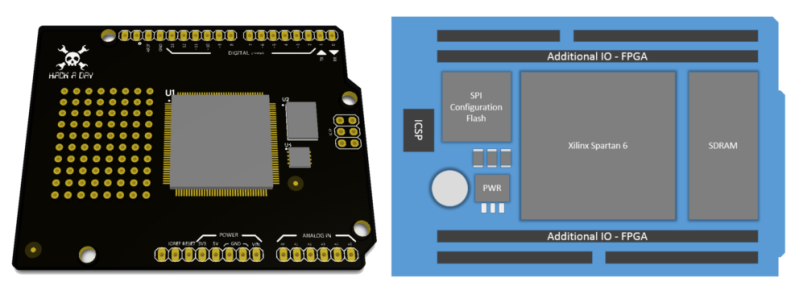We are now working on developing an FPGA Development Board - Spartan Edge Accelerator Board or you can call it the SEA board.
The board is based on Spartan-7, one of the newest and most cost-effective chip among Xilinx’s FPGA family. The board is Arduino form factor, it can be used as Arduino shield to driver LCD or camera, or can be used as single FPGA development board without Arduino.
The most exciting part is that the SEA board has developed the FPGA APIs for Arduino, which means Arduino users are able to use the FPGA function without knowing a thing about FPGA.
This board will broaden Arduino’s capability in many ways like:
• Simple image processing and computer vision application
• Signal encryption and decryption
• Signal sampling and processing
In addition, it has an ESP32 on-board, can provide wifi and bluetooth connectivity to Arduino.
Here is some basic specification:
Core:
• FPGA Chip: Spartan-7
• WiFi/BLE: ESP32
Peripheral:
• 1 x Mini HDMI
• 1 x Camera
• 1 x SD Card Slot
• 2 x Grove (Current is 3, will remove 1)
• 2 x LED
• 2 x RGB LED
• 10 FPGA GPIO is breakout as through holes on the board.
Power:
• USB-C
Estimated retail price is $34.9. We are looking forward to your suggestions! What do you think of this board, do you like it? Do you have any awesome project on your mind? Feel free to let us know your thoughts, we will carefully listen to all suggestions and help the community!


The price point would be compelling to have a couple of boards around. I was thinking of a high speed ADC for a high performance poor mans scope as one item on my list.
I am a bit confused… why Arduino shield? Since this board has almost everything, I think this board itself can be an Arduino-compatible board with the onboard ESP32. As an added benefit, MicroPython can also be used.
The groves and LEDs position is OK but when you stack a shield on the top of this board, LEDs will not be visible and grove cables may come in between them. May be repositioning them near the edges would be better.
Very interesting board, but I’m also confused. Why should this be a shield? Make it a stand-alone board with the ESP32 as main processor, or perhaps a (software) microcprocessor core inside the FPGA.
Very interesting to see how users would program the FPGA and what the possibilities are.
Sorry that we didn’t list all the features clearly. This board can be used as a stand-along FPGA development board without Arduino. Will update the description soon.
Sorry that we didn’t list all the features clearly. This board can be used as a stand-alone FPGA development board without Arduino. Will update the description soon.
I can imagine that it’s still a little bit confusing to imagine this board as a shield for Arduino, as it can act perfectly by itself.
This open the possibility of this FPGA Board to become a series of boards, like those Sipeed boards - e.g. - An independent/solo board, a shield/hat version, etc…
One suggestion that I can see for this little guy for now is to expose more pins!
If the intention is to have it “also” as an Arduino Shield, I think it would be excellent to expose both the Arduino pins (as does the shields, normally), and also expose pins of the “accelerator” shield itself.
Think of it like this shield, that appeared on Hackaday:

See the “Additional I/O FPGA” lines in the middle of the picture in the right, along with the Arduino headers on the extremities.
And, a final suggestion, could you think in a Raspberry Pi HAT in the same way? I think it would be even more useful as the “edge accelerator” that this board intend to be!
And about the FPGA Programming, how is it going to be done?
Normally those FPGA boards have some kind of JTAG interface, some native, through USB, some through the exposal of the pins and the usage of an external JTAG.
I can see in the board that you are exposing the JTAG pins above the Grove connectors, so to “reprogram” the FPGA it will be through and external JTAG?
Will it be possible to be “done” by some incorporated JTAG-Serial interface, like some FT2232?
The programming question is the big one for me. To use ft2232 with Vivado you need a Digilent licence with is something like $US12 per board so that seems to be out of the question.
I’m working on Xilinx (artix-7) support for the fomu bootloader, this uses valenty usb to bit bang USB1.1 and support flash programming using DFU. See https://github.com/im-tomu/foboot
I expect they are working on something that uses the esp32.
[list=]
[list=]
[list]
Hi Andre,
That’s a good question.
Programming can be done through JTAG. Another way is through ESP32, ESP32 will read the program from SD card, and send to the Spartan-7.
Hi Andre,
Thanks for the suggestion.
In the current version, we did breakout 10 FPGA pins beside the Arduino female pin headers. the style from the “Hackday Board” will require more space, maybe not suitable for this version.
Raspberry Pi HAT is a great idea! It is what we definitely will consider in the future.
Hi,
If I want more Ram for my FPGA to do image processing or something like that, what need I do?!
Best Regards,
Yousef Yazdi
Got my board in the mail the other day…looks good, but I have to say I am a little underwhelmed with the tutorial available. I have not used FPGAs before and the linked bitstream file in the Tutorial can’t be downloaded. So I can’t even make sure the thing works…any advice?
Hello, I want to follow through on the discussion about building a version of this unit that is a Raspberry Pi hat instead of an Arduino hat. I’ve been working with two boards recently, this one and a Trenz Electronics “Zynqberry,” a Zynq 7000 in a Raspberry Pi form factor. Without going into details what I’ve found with the latter is that it’s just too complex. I realized what would be AMAZING would be if this Spartan Edge Accelerator Board were for a Raspberry Pi. It would leave you with a compact unit with Embedded Linux, an MCU (and not just any one but an ESP32!) AND FPGA fabric.
PLEASE consider making a Raspberry Pi version of this board. I’m guessing the extra effort would be relatively minimal and I’m certain it will be a winner!